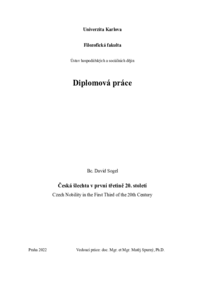Česká šlechta v první třetině 20. století
Czech nobility in the first third of the 20th century
diplomová práce (OBHÁJENO)

Zobrazit/
Trvalý odkaz
http://hdl.handle.net/20.500.11956/171710Identifikátory
SIS: 216731
Kolekce
- Kvalifikační práce [24155]
Autor
Vedoucí práce
Oponent práce
Žáková, Michaela
Fakulta / součást
Filozofická fakulta
Obor
Historie - hospodářské a sociální dějiny - Německý jazyk a literatura
Katedra / ústav / klinika
Ústav hospodářských a sociálních dějin
Datum obhajoby
1. 2. 2022
Nakladatel
Univerzita Karlova, Filozofická fakultaJazyk
Čeština
Známka
Velmi dobře
Klíčová slova (česky)
Rakousko-Uhersko|Československo|šlechta|šlechtické rody|první světová válka|první pozemková reforma|habitusKlíčová slova (anglicky)
Austria-Hungary|Czechoslovakia|nobility|nobel families|WWI|first land reform|habitusDiplomová práce Česká šlechta v 1. třetině 20. století analyzuje význam šlechty žijící na území Čech, konkrétně pěti vybraných rodů, a to Auerspergů, Buquoyů, Czerninů, Metternichů- Winneburgů a Schaumburgů-Lippe, po vzniku Československé republiky roku 1918. Pozornost je po celou dobu zaměřena na tyto rody, jejich život a strategie v nově vzniklém státu. Práce si klade za cíl analyzovat jejich reakce na změnu státního zřízení, na probíhající pozemkovou reformu, na zrušení užívání šlechtických titulů vedoucího k zániku jejich privilegovaného společenského postavení, stejně jako na propojení individuální a kolektivní složky šlechtictví. Metodologicky se práce opírá o koncepty Pierra Bourdieu a Fernand Braudela, konkrétně o pojetí habitu, kapitálu, sociálního pole, dlouhého trvání a tzv. nové šlechty. Úvodní části práce, tedy historický kontext, prameny a metodologické přístupy, mají za cíl ukázat vhodnost užití těchto konceptů pro výzkum šlechty. Následující, tedy empirická část práce, která začíná pátou kapitolou, zkoumá jednotlivá pole šlechty, přičemž první popisovanou oblastí je pole politické. U něj je důraz kladen na otázku postoje zkoumaných rodů vůči Československu. Jádro práce představuje následující šestá kapitola, která mimo jiné prokazuje kontinuity šlechtictví i po roce 1918, analyzuje...
The diploma thesis Czech Nobility in the First Third of the 20th Century analyses the significance of the nobility living in Bohemia after the establishment of Czechoslovakia in 1918. The focus is put on five of the noble families, specifically Auersperg, Buquoy, Czernin, Metternich-Winneburg and Schaumburg-Lippe, their lives, and their strategies in the newly formed republic. The aim of the thesis is to analyse their reactions to the change of the establishment, the ongoing land reform, the abolition of the aristocratic titles and their use leading to the end of their privileged social status as well as the joint of the individual and collective aspects of the nobility. From the methodological point of view, the thesis is based on the concepts of Pierre Bourdieu and Fernand Braudel, specifically the concept of habitus, capital, social fields, longue durée and the so-called new nobility. The introductory parts of the thesis, the historical context, sources, and the methodological approaches, aim to demonstrate the suitability of the use of these concepts for the study of nobility. The following part, empirical part of the thesis, beginning by the fifth chapter, studies the individual fields of nobility, with the first area being the political field. The accent is put on the attitude of the studied...
